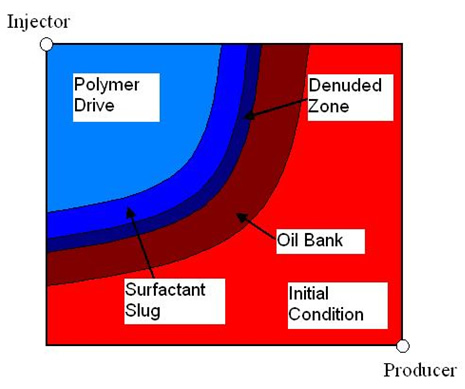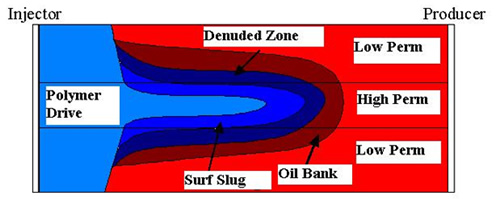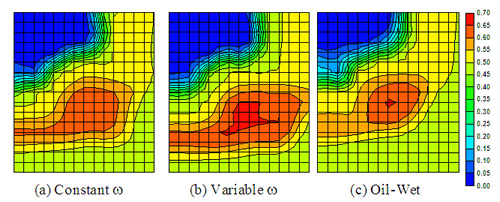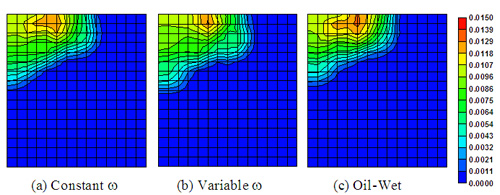Laboratory surfactant floods have shown a great potential to increase oil recovery from reservoirs that are naturally fractured and have low-permeability oil-wet or mixed- wet matrix rocks. The mechanisms for increased oil recovery are the combined effects of reduced interfacial tension and wettabillity alteration. All of these mechanisms are favorable for increased capillary imbibition. These processes have not been tested at either the pilot or field scale mainly due to lack of complete understanding of the complex mechanisms involved. The goal of this project is to adapt an existing numerical reservoir simulator, UTCHEM, to model chemical processes that trigger wettability alteration in naturally fractured reservoirs.
Results
Researchers have developed and implemented a model in the UTCHEM chemical simulator to account for wettability alteration as the result of surfactant injection. The model presently takes into account the changes in the relative permeability, capillary pressure, and capillary desaturation curves. The model and its implementation in UTCHEM have been validated against published laboratory results. Several field scale simulations were performed to test the validity of the model.
To date, researchers have:
- Developed and implemented a model for wettability alteration in UTCHEM.
- Validated the model and its implementation by successfully history matching the published laboratory imbibition cell test results in a mixed wet carbonate matrix rock.
- Performed simulations with the improved model to scale up the processes involved in the oil recovery from the mixed-wet naturally fractured oil reservoirs from laboratory scale to field scale.
- Performed field-scale simulations with different wettability conditions.
- Conducted surfactant flooding simulations in fractured reservoirs with wettability alteration.
- Compared several published dimensionless times for the rate of spontaneous imbibition.
Benefits
The chemical simulator UTCHEM was enhanced by adding the capability of modeling wettability alteration during chemical EOR processes. This addition will provide a unique simulator that can model surfactant floods in naturally fractured reservoirs by coupling wettability effects on relative permeabilities, capillary pressure, and capillary desaturation curves. This is a new and potentially very important application of simulation technology that has never been attempted despite the enormous volumes of oil remaining in naturally fractured reservoirs. Numerical simulations are needed to scale up and predict the performance of field-scale applications of chemical EOR. The improved chemical compositional simulator resulting from this project will enable the development of cost-effective chemical EOR processes because it can model surfactant phase behavior, temperature-dependent fluid properties, and wettability-dependent petrophysical properties in naturally fractured reservoirs. This simulator will be the first to incorporate all of these features.
Summary
The performance of waterflooding in naturally fractured reservoirs is normally low. This is due to the fact that most of the fractured reservoirs are oil-wet or mixed-wet and as a result have a low tendency for imbibition of injected water into the matrix. The main oil recovery mechanism in these reservoirs is imbibition of the injected water into the matrix and expulsion of oil to the fractures; therefore, the tendency of the matrix rock for imbibing the injected fluid plays an important role in oil recovery from these nonconventional reservoirs. It is desirable to change the wetting state of the matrix rocks to more water-wet conditions in order to increase the rate of imbibition of the injected water. This can be achieved by injection of a surface active agent (surfactant).
Surfactant solutions have two important effects on the rock/fluid system. The first effect is reduction of interfacial tension between the trapped oil and injected aqueous phase and therefore solubilization and mobilization of trapped oil. The second effect is the alteration of the wettability of the matrix rock towards more water-wet conditions, which would increase the brine imbibition rates.
The primary focus of this research is on surfactant processes that recover additional oil through ultralow interfacial tension and wettability alteration.
The effect of surfactant on wettability alteration was modeled and implemented in UTCHEM by changing relative permeability, capillary pressure, and capillary desaturation curves. The model was validated by a successful comparison with the published imbibition-cell surfactant experiment. Three-dimensional simulations of dilute surfactant flooding in a naturally fractured reservoir model demonstrated the significance of wettability alteration from mixed wet to water wet conditions on increasing the oil production. The simulation tool developed aids in a mechanistic understanding of low concentration surfactant flooding in fractured carbonate reservoirs. With the wettability alteration capability in UTCHEM, several EOR processes that use chemicals such as surfactants—polymer and alkali, or in some cases mixtures of them, that recover additional oil through low interfacial tension and wettability alteration—can now be simulated.
The enhanced simulator will make it possible to select and optimize the best candidates for field application and tailor an EOR process design to the particular characteristics of each reservoir. It can also aid in the scale-up of the process from the laboratory scale to the field scale. The scale-up is crucial to predict the time required to achieve the same performance under field conditions, taking into the consideration matrix block sizes, matrix block heights, and other uncertain field conditions.










